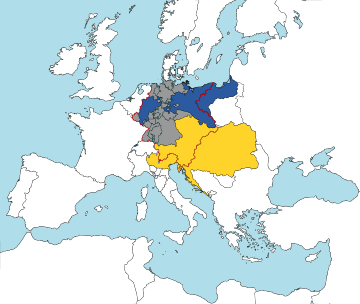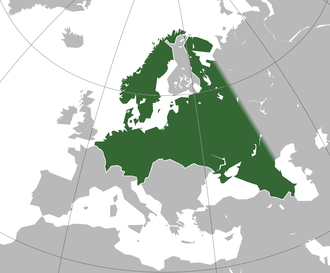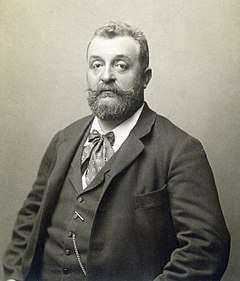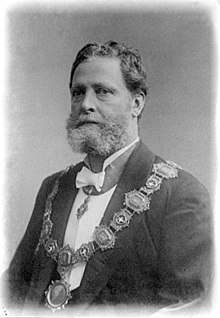Pan-Germanism
Pan-Germanism (German: Pangermanismus or Alldeutsche Bewegung), also occasionally known as Pan-Germanicism, is a pan-nationalist political idea. Pan-Germanists originally sought to unify all the German-speaking people – and possibly also Germanic-speaking peoples – in a single nation-state known as Großdeutschland.
.jpg)
Pan-Germanism was highly influential in German politics in the 19th century during the unification of Germany when the German Empire was proclaimed as a nation-state in 1871 but without Austria (Kleindeutsche Lösung/Lesser Germany),[1] and the first half of the 20th century in the Austro-Hungarian Empire and the German Empire. From the late 19th century, many Pan-Germanist thinkers, since 1891 organized in the Pan-German League, had adopted openly ethnocentric and racist ideologies, and ultimately gave rise to the foreign policy Heim ins Reich pursued by Nazi Germany under Austrian-born Adolf Hitler from 1938, one of the primary factors leading to the outbreak of World War II.[2][3][4][5] As a result of the disaster of World War II, Pan-Germanism was mostly seen as a taboo ideology in the postwar period in both West and East Germany. Today, Pan-Germanism is mainly limited to some nationalist groups in Germany and Austria.
Etymology
The word pan is a Greek word element meaning "all, every, whole, all-inclusive". The word "German" in this context derives from Latin "Germani" originally used by Julius Caesar referring to tribes or a single tribe in northeastern Gaul. In the Late Middle Ages, it acquired a loose meaning referring to the speakers of Germanic languages (alongside 'Almain' and 'Teuton') most of whom spoke dialects ancestral to modern German. In English, "Pan-German" was first attested in 1892. In German, there exists a synonym "Alldeutsche Bewegung" which is a calque using German instead of Latin and Greek roots.[6]
Origins (before 1860)

Pan-Germanism's origins began with the birth of Romantic nationalism during the Napoleonic Wars, with Friedrich Ludwig Jahn and Ernst Moritz Arndt being early proponents. Germans, for the most part, had been a loose and disunited people since the Reformation, when the Holy Roman Empire was shattered into a patchwork of states following the end of the Thirty Years' War with the Peace of Westphalia.
Advocates of the Großdeutschland (Greater Germany) solution sought to unite all the German-speaking people in Europe, under the leadership of the German Austrians from the Austrian Empire. Pan-Germanism was widespread among the revolutionaries of 1848, notably among Richard Wagner and the Brothers Grimm.[4] Writers such as Friedrich List and Paul Anton Lagarde argued for German hegemony in Central and Eastern Europe, where German domination in some areas had begun as early as the 9th century AD with the Ostsiedlung, Germanic expansion into Slavic and Baltic lands. For the Pan-Germanists, this movement was seen as a Drang nach Osten, in which Germans would be naturally inclined to seek Lebensraum by moving eastwards to reunite with the German minorities there.
The Deutschlandlied ("Song of Germany"), written in 1841 by Hoffmann von Fallersleben, in its first stanza defines Deutschland as reaching "From the Meuse to the Memel / From the Adige to the Belt", i.e. as including East Prussia and South Tyrol.
Reflecting upon the First Schleswig War in 1848, Karl Marx noted in 1853 that "by quarrelling amongst themselves, instead of confederating, Germans and Scandinavians, both of them belonging to the same great race, only prepare the way for their hereditary enemy, the Slav."[7]
The German Question
There is, in political geography, no Germany proper to speak of. There are Kingdoms and Grand Duchies, and Duchies and Principalities, inhabited by Germans, and each separately ruled by an independent sovereign with all the machinery of State. Yet there is a natural undercurrent tending to a national feeling and toward a union of the Germans into one great nation, ruled by one common head as a national unit.
By the 1860s the Kingdom of Prussia and the Austrian Empire had become the two most powerful states dominated by German-speaking élites. Both sought to expand their influence and territory. The Austrian Empire—like the Holy Roman Empire—was a multi-ethnic state, but the German-speaking people there did not have an absolute numerical majority; its re-shaping into the Austro-Hungarian Empire was one result of the growing nationalism of other ethnicities—especially the Hungarians. Under Prussian leadership, Otto von Bismarck would ride on the coat-tails of nationalism to unite all of the northern German lands. After Bismarck excluded Austria and the German Austrians from Germany in the German war of 1866 and (following a few other events over the next few years), the unification of Germany, established the Prussian-dominated German Empire ("Second Reich") in 1871 with the proclamation of Wilhelm I as head of a union of German-speaking states, while disregarding millions of its non-German subjects who desired self-determination from German rule. After World War I the Pan-Germanist philosophy changed drastically during the ascendancy of Adolf Hitler. Pan-Germanists originally sought to unify all the German-speaking populations of Europe in a single nation-state known as Großdeutschland (Greater Germany), where "German-speaking" was sometimes taken as synonymous with Germanic-speaking, to the inclusion of the Frisian- and Dutch-speaking populations of the Low Countries, and Scandinavia.[9]
Although Bismarck had excluded Austria and the German Austrians from his creation of the Kleindeutschland state in 1871, integrating the German Austrians nevertheless remained a strong desire for many people of both Austria and Germany.[10] The most radical Austrian pan-German Georg Schönerer (1842–1921) and Karl Hermann Wolf (1862–1941) articulated Pan-Germanist sentiments in the Austro-Hungarian Empire.[2] There was also a rejection of Roman Catholicism with the Away from Rome! movement (ca 1900 onwards) calling for German-speakers to identify with Lutheran or Old Catholic churches.[5] The Pan-German Movement gained an institutional format in 1891, when Ernst Hasse, a professor at the University of Leipzig and a member of the Reichstag, organized the Pan-German League, an ultra-nationalist[11] political-interest organization which promoted imperialism, anti-semitism, and support for ethnic German minorities in other countries.[12] The organization achieved great support among the educated middle and upper class; it promoted German nationalist consciousness, especially among ethnic Germans outside Germany. In his three-volume work, "Deutsche Politik" (1905–07), Hasse called for German imperialist expansion in Europe. The Munich professor Karl Haushofer, Ewald Banse, and Hans Grimm (author of the novel Volk ohne Raum) preached similar expansionist policies.
Pan-Germanism in Austria
After the Revolutions of 1848/49, in which the liberal nationalistic revolutionaries advocated the Greater German solution, the Austrian defeat in the Austro-Prussian War (1866) with the effect that Austria was now excluded from Germany, and increasing ethnic conflicts in the multinational Habsburg Monarchy, a German national movement evolved in Austria.[13] Led by the radical German nationalist and anti-semite Georg von Schönerer, organisations such as the Pan-German Society demanded the annexation of all German-speaking territories of the Danube Monarchy to the German Empire, and fervently rejected Austrian patriotism and a pan-Austrian identity. Schönerer's völkisch and racist German nationalism was an inspiration to Hitler's Nazi ideology.[14]
In 1933, Austrian Nazis and the national-liberal Greater German People's Party formed an action group, fighting together against the Austrofascist regime which imposed a distinct Austrian national identity and in accordance said that Austrians were "better Germans", while Kurt Schuschnigg adopted a policy of appeasement towards Austrian-born Hitler's annexing of Austria to Nazi Germany and called Austria the "better German state", but he still struggled to keep Austria independent.[15] With "Anschluss" of Austria in 1938, the historic aim of Austria's German nationalists was achieved.[16]
After the end of Nazi Germany and the events of World War II in 1945, the ideas of pan-Germanism and an Anschluss fell out of favour due to their association with Nazism and allowed Austrians to develop their own national identity. Nevertheless, such notions were revived with the German national camp in the Federation of Independents and the early Freedom Party of Austria.[17]
Pan-Germanism in Scandinavia
The idea of including the North Germanic-speaking Scandinavians into a Pan-German state, sometimes referred to as Pan-Germanicism,[18] was promoted alongside mainstream pan-German ideas.[19] Jacob Grimm adopted Munch's anti-Danish Pan-Germanism and argued that the entire peninsula of Jutland had been populated by Germans before the arrival of the Danes and that thus it could justifiably be reclaimed by Germany, whereas the rest of Denmark should be incorporated into Sweden. This line of thinking was countered by Jens Jacob Asmussen Worsaae, an archaeologist who had excavated parts of Danevirke, who argued that there was no way of knowing the language of the earliest inhabitants of Danish territory. He also pointed out that Germany had more solid historical claims to large parts of France and England, and that Slavs—by the same reasoning—could annex parts of Eastern Germany. Regardless of the strength of Worsaae's arguments, pan-Germanism spurred on the German nationalists of Schleswig and Holstein and led to the First Schleswig War in 1848. In turn, this likely contributed to the fact that Pan-Germanism never caught on in Denmark as much as it did in Norway.[20] Pan-Germanic tendencies were particularly widespread among the Norwegian independence movement. Prominent supporters included Peter Andreas Munch, Christopher Bruun, Knut Hamsun, Henrik Ibsen and Bjørnstjerne Bjørnson.[4][21][22] Bjørnson, who wrote the lyrics for the Norwegian national anthem, proclaimed in 1901:
I'm a Pan-Germanist, I'm a Teuton, and the greatest dream of my life is for the South Germanic peoples and the North Germanic peoples and their brothers in diaspora to unite in a fellow confederation.[4]
In the 20th century the German Nazi Party sought to create a Greater Germanic Reich that would include most of the Germanic peoples of Europe within it under the leadership of Germany, including peoples such as the Danes, the Dutch, the Swedes, the Norwegians, and the Flemish within it.[23]
Anti-German Scandinavism surged in Denmark in the 1930s and 1940s in response to the pan-Germanic ambitions of Nazi Germany.[24]
1918 to 1945


World War I became the first attempt to carry out the Pan-German ideology in practice, and the Pan-German movement argued forcefully for expansionist imperialism.[26]
Following the defeat in World War I, the influence of German-speaking elites over Central and Eastern Europe was greatly limited. At the Treaty of Versailles, Germany was substantially reduced in size. Austria-Hungary was split up. A Rump-Austria, which to a certain extent corresponded to the German-speaking areas of Austria-Hungary (a complete split into language groups was impossible due to multi-lingual areas and language-exclaves) adopted the name "German Austria" (German: Deutschösterreich) in hope for union with Germany. Union with Germany and the name "German Austria" was forbidden by the Treaty of St. Germain and the name had to be changed back to Austria.
It was in the post-World War I period that the Austrian-born Adolf Hitler, under the influence of the stab-in-the-back myth, first took up German nationalist ideas in his Mein Kampf.[26] Hitler met Heinrich Class in 1918, and Class provided Hitler with support for the 1923 Beer Hall Putsch. Hitler and his National Socialist friends shared most of the basic pan-German visions with the Pan-German League, but differences in political style led the two groups to open rivalry. The German Workers Party of Bohemia cut its ties to the pan-German movement, which was seen as being too dominated by the upper classes, and joined forces with the German Workers Party led by Anton Drexler, which later became the National Socialist German Workers Party (Nazi party) that was to be headed by Adolf Hitler from 1921.[27]
Nazi propaganda also used the political slogan Ein Volk, ein Reich, ein Führer ("One people, one Reich, one leader"), to enforce pan-German sentiment in Austria for an "Anschluss".
The Heim ins Reich ("Back Home to the Reich") initiative was a policy pursued by the Nazis which attempted to convince the ethnic Germans living outside of Nazi Germany (such as in Austria and Sudetenland) that they should strive to bring these regions "home" into a Greater Germany. This notion also led the way for an even more expansive state to be envisioned, the Greater Germanic Reich, which Nazi Germany tried to establish.[28] This pan-Germanic empire was expected to assimilate practically all of Germanic Europe into an enormously expanded Greater Germanic Reich. Territorially speaking, this encompassed the already-enlarged Reich itself (consisting of pre-1938 Germany plus the areas annexed into the Großdeutsche Reich), the Netherlands, Belgium, areas in north-eastern France considered to be historically and ethnically Germanic, Denmark, Norway, Sweden, Iceland, at least the German-speaking parts of Switzerland, and Liechtenstein.[29] The most notable exception was the predominantly Anglo-Saxon United Kingdom, which was not projected as having to be reduced to a German province but to instead become an allied seafaring partner of the Germans.[30]
The eastern Reichskommissariats in the vast stretches of Ukraine and Russia were also intended for future integration, with plans for them stretching to the Volga or even beyond the Urals. They were deemed of vital interest for the survival of the German nation, as it was a core tenet of national-socialist ideology that it needed "living space" (Lebensraum), creating a "pull towards the East" (Drang nach Osten) where that could be found and colonized, in a model that the Nazis explicitly derived from the American Manifest Destiny in the Far West and its clearing of native inhabitants.
History since 1945
The defeat of Germany in World War II brought about the decline of Pan-Germanism, much as World War I had led to the demise of Pan-Slavism. Parts of Germany itself were devastated, and the country was divided, firstly into Soviet, French, American, and British zones and then into West Germany and East Germany. To add to the disaster, Germany suffered even larger territorial losses than it did in the First World War, with vast portions of eastern Germany directly annexed by the Soviet Union and Poland. The scale of the Germans' defeat was unprecedented; Pan-Germanism became taboo because it had been tied to racist concepts of the "master race" and Nordicism by the Nazi party. However, the reunification of Germany in 1990 revived the old debates.[31]
See also
Up to and during 18th century
- Germanic peoples
- Germania
- Peace of Westphalia
- Holy Roman Empire of the German Nation
19th century
- German nationalism
- Pan-German League
- Völkisch movement
- Pan-nationalism
- German question (with Großdeutsche Lösung)
- Scandinavism
- Irredentism
- Romantic nationalism
- Folklore
20th century
- German reunification (with German unity)
- Nazi Germany
- Greater Germanic Reich
- Anschluss
- German nationalism in Austria
- Versailles Treaty
- Ethnic nationalism
- Expansionism
- Mitteleuropa
References
- Timothy Kirk (8 August 2002). Nazism and the Working Class in Austria: Industrial Unrest and Political Dissent in the 'National (Community'. Cambridge University Press. p. 21. ISBN 978-0-521-52269-4.
- "Pan-Germanism (German political movement) – Britannica Online Encyclopedia". Britannica.com. Retrieved 24 January 2012.
- Origins and Political Character of Nazi Ideology Hajo Holborn Political Science Quarterly Vol. 79, No. 4 (Dec. 1964), p.550
- "Slik ble vi germanersvermere – magasinet". Dagbladet.no. Retrieved 24 January 2012.
- Mees, Bernard (2008). The Science of the Swastika. Central European University Press. ISBN 978-963-9776-18-0.
- http://www.etymonline.com (pan-, German)
- Marx, Karl (1994). The Eastern Question. Taylor & Francis Group. p. 90. ISBN 0-7146-1500-5.
- "The Situation of Germany" (PDF). The New York Times. 1 July 1866. Retrieved 21 August 2017.
- Nationalism and Globalisation: Conflicting Or Complementary. D. Halikiopoulou. p51.
- "Das politische System in Österreich (The Political System in Austria)" (PDF) (in German). Vienna: Austrian Federal Press Service. 2000. p. 24. Archived from the original (PDF) on 23 April 2014. Retrieved 9 July 2014.
- Eric J. Hobsbawm (1987). The age of empire, 1875–1914. Pantheon Books. p. 152. ISBN 978-0-394-56319-0. Retrieved 22 March 2011.
- Drummond, Elizabeth A. (2005). "Pan-German League". In Levy, Richard S. (ed.). Antisemitism: A Historical Encyclopedia of Prejudice and Persecution. Contemporary world issues. 1. ABC-CLIO. pp. 528–529. ISBN 9781851094394. Retrieved 15 July 2016.
- Bauer, Kurt (2008), Nationalsozialismus: Ursprünge, Anfänge, Aufstieg und Fall (in German), Böhlau Verlag, p. 41
- Wladika, Michael (2005), Hitlers Vätergeneration: Die Ursprünge des Nationalsozialismus in der k.u.k. Monarchie (in German), Böhlau Verlag, p. 157
- Morgan, Philip (2003). Fascism in Europe, 1919–1945. Routledge. p. 72. ISBN 0-415-16942-9.
- Bideleux, Robert; Jeffries, Ian (1998), A history of eastern Europe: Crisis and Change, Routledge, p. 355
- Pelinka, Anton (2000), "Jörg Haiders "Freiheitliche" – ein nicht nur österreichisches Problem", Liberalismus in Geschichte und Gegenwart (in German), Königshausen & Neumann, p. 233
- Thomas Pedersen. Germany, France, and the integration of Europe: a realist interpretation. Pinter, 1998. P. 74
- Ian Adams. Political Ideology Today. Manchester, England, UK: Manchester University Press, 1993. P. 95.
- Rowly-Conwy, Peter (2013). "THE CONCEPT OF PREHISTORY AND THE INVENTION OF THE TERMS 'PREHISTORIC' AND 'PREHISTORIAN': THE SCANDINAVIAN ORIGIN, 1833–1850" (PDF). European Journal of Archaeology. 9 (1): 103–130. doi:10.1177/1461957107077709.
- NRK (20 January 2005). "Drømmen om Norge". NRK.no. Retrieved 24 January 2012.
- Larson, Philip E. (1999). Ibsen in Skien and Grimstad: His education, reading, and early works (PDF). Skien: The Ibsen House and Grimstad Town Museum. p. 143.
- Germany: The Long Road West: Volume 2: 1933–1990. Digital version. Oxford, England, UK: Oxford University Press, 2007.
- Stephen Barbour, Cathie Carmichael. Language and Nationalism in Europe. Oxford, England, UK: Oxford University Press, 2000. P. 111.
- "Utopia: The 'Greater Germanic Reich of the German Nation'". München – Berlin: Institut für Zeitgeschichte. 1999. Archived from the original on 14 December 2013. Retrieved 24 January 2012.
- World fascism: a historical encyclopedia, Volume 1 Cyprian Blamires ABC-CLIO, 2006. pp. 499–501
- Antisemitism: A Historical Encyclopedia of Prejudice and Persecution, Volume 1, Richard S. Levy, 529–530, ABC-CLIO 2005
- Elvert 1999, p. 325.
- Rich 1974, pp. 401–402.
- Strobl 2000, pp. 202–208.
- Zeilinger, Gerhard (16 June 2011). "Straches "neue" Heimat und der Boulevardsozialismus". Der Standard (in German). Retrieved 28 June 2011.
Further reading
- Kleineberg, A.; Marx Chr.; Knobloch E.; Lelgemann D.: Germania und die Insel Thule. Die Entschlüsselung von Ptolemaios'"Atlas der Oikumene". WBG 2010. ISBN 978-3-534-23757-9.
- Jackisch, Barry Andrew. 'Not a Large, but a Strong Right': The Pan-German League, Radical Nationalism, and Rightist Party Politics in Weimar Germany, 1918–1939. Bell and Howell Information and Learning Company: Ann Arbor. 2000.
- Wertheimer, Mildred. The Pan-German League, 1890–1914. Columbia University Press: New York. 1924.
- Chickering, Roger. We Men Who Feel Most German: Cultural Study of the Pan-German League, 1886–1914. Harper Collins Publishers Ltd. 1984.

